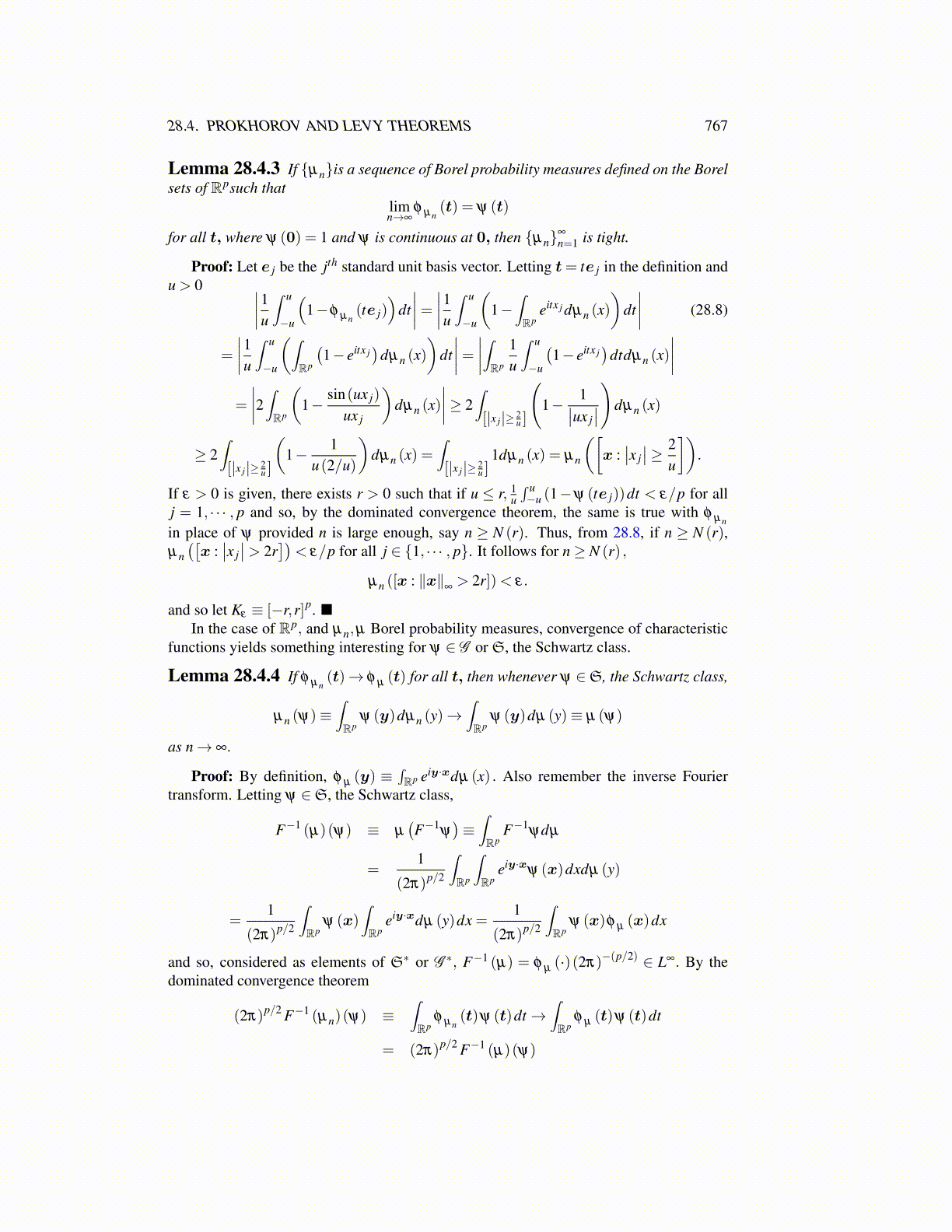
28.4. PROKHOROV AND LEVY THEOREMS 767
Lemma 28.4.3 If {µn}is a sequence of Borel probability measures defined on the Borelsets of Rpsuch that
limn→∞
φ µn(t) = ψ (t)
for all t, where ψ (0) = 1 and ψ is continuous at 0, then {µn}∞
n=1 is tight.
Proof: Let e j be the jth standard unit basis vector. Letting t= te j in the definition andu > 0 ∣∣∣∣1u
∫ u
−u
(1−φ µn
(te j))
dt∣∣∣∣= ∣∣∣∣1u
∫ u
−u
(1−
∫Rp
eitx j dµn (x))
dt∣∣∣∣ (28.8)
=
∣∣∣∣1u∫ u
−u
(∫Rp
(1− eitx j
)dµn (x)
)dt∣∣∣∣= ∣∣∣∣∫Rp
1u
∫ u
−u
(1− eitx j
)dtdµn (x)
∣∣∣∣=
∣∣∣∣2∫Rp
(1−
sin(ux j)
ux j
)dµn (x)
∣∣∣∣≥ 2∫[|x j|≥ 2
u ]
(1− 1∣∣ux j
∣∣)
dµn (x)
≥ 2∫[|x j|≥ 2
u ]
(1− 1
u(2/u)
)dµn (x) =
∫[|x j|≥ 2
u ]1dµn (x) = µn
([x :∣∣x j∣∣≥ 2
u
]).
If ε > 0 is given, there exists r > 0 such that if u ≤ r, 1u∫ u−u (1−ψ (te j))dt < ε/p for all
j = 1, · · · , p and so, by the dominated convergence theorem, the same is true with φ µnin place of ψ provided n is large enough, say n ≥ N (r). Thus, from 28.8, if n ≥ N (r),µn([x :∣∣x j∣∣> 2r
])< ε/p for all j ∈ {1, · · · , p}. It follows for n≥ N (r) ,
µn ([x : ∥x∥∞> 2r])< ε.
and so let Kε ≡ [−r,r]p. ■In the case of Rp, and µn,µ Borel probability measures, convergence of characteristic
functions yields something interesting for ψ ∈ G or S, the Schwartz class.
Lemma 28.4.4 If φ µn(t)→ φ µ (t) for all t, then whenever ψ ∈S, the Schwartz class,
µn (ψ)≡∫Rp
ψ (y)dµn (y)→∫Rp
ψ (y)dµ (y)≡ µ (ψ)
as n→ ∞.
Proof: By definition, φ µ (y) ≡∫Rp eiy·xdµ (x) . Also remember the inverse Fourier
transform. Letting ψ ∈S, the Schwartz class,
F−1 (µ)(ψ) ≡ µ(F−1
ψ)≡∫Rp
F−1ψdµ
=1
(2π)p/2
∫Rp
∫Rp
eiy·xψ (x)dxdµ (y)
=1
(2π)p/2
∫Rp
ψ (x)∫Rp
eiy·xdµ (y)dx =1
(2π)p/2
∫Rp
ψ (x)φ µ (x)dx
and so, considered as elements of S∗ or G ∗, F−1 (µ) = φ µ (·)(2π)−(p/2) ∈ L∞. By thedominated convergence theorem
(2π)p/2 F−1 (µn)(ψ) ≡∫Rp
φ µn(t)ψ (t)dt→
∫Rp
φ µ (t)ψ (t)dt
= (2π)p/2 F−1 (µ)(ψ)